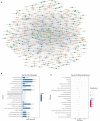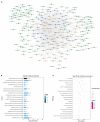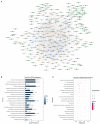Comprehensive circRNA Expression Profile and Construction of circRNAs-Related ceRNA Network in a Mouse Model of Autism
- PMID: 33679870
- PMCID: PMC7928284
- DOI: 10.3389/fgene.2020.623584
Comprehensive circRNA Expression Profile and Construction of circRNAs-Related ceRNA Network in a Mouse Model of Autism
Abstract
Autism is a common disease that seriously affects the quality of life. The role of circular RNAs (circRNAs) in autism remains largely unexplored. We aimed to detect the circRNA expression profile and construct a circRNA-based competing endogenous RNA (ceRNA) network in autism. Valproate acid was used to establish an in vivo model of autism in mice. A total of 1,059 differentially expressed circRNAs (477 upregulated and 582 downregulated) in autism group was identified by RNA sequencing. The expression of novel_circ_015779 and novel_circ_035247 were detected by real-time PCR. A ceRNA network based on altered circRNAs was established, with 9,715 nodes and 150,408 edges. Module analysis was conducted followed by GO and KEGG pathway enrichment analysis. The top three modules were all correlated with autism-related pathways involving "TGF-beta signaling pathway," "Notch signaling pathway," "MAPK signaling pathway," "long term depression," "thyroid hormone signaling pathway," etc. The present study reveals a novel circRNA involved mechanisms in the pathogenesis of autism.
Keywords: RNA sequencing (RNA-Seq); autism; ceRNA network; circular RNA (circRNA); in silico analysis.
Copyright © 2021 Wang, Yang, Chen, Xu, Wang, Liu, Zhang and Jiang.
Conflict of interest statement
The authors declare that the research was conducted in the absence of any commercial or financial relationships that could be construed as a potential conflict of interest.
Figures








Similar articles
-
Comprehensive circRNA expression profile and construction of circRNA-related ceRNA network in cardiac fibrosis.Biomed Pharmacother. 2020 May;125:109944. doi: 10.1016/j.biopha.2020.109944. Epub 2020 Feb 12. Biomed Pharmacother. 2020. PMID: 32062386
-
Comprehensive Construction of a Circular RNA-Associated Competing Endogenous RNA Network Identified Novel Circular RNAs in Hypertrophic Cardiomyopathy by Integrated Analysis.Front Genet. 2020 Jul 28;11:764. doi: 10.3389/fgene.2020.00764. eCollection 2020. Front Genet. 2020. PMID: 32849787 Free PMC article.
-
Crosstalk in competing endogenous RNA networks reveals new circular RNAs involved in the pathogenesis of early HIV infection.J Transl Med. 2018 Nov 29;16(1):332. doi: 10.1186/s12967-018-1706-1. J Transl Med. 2018. PMID: 30486834 Free PMC article.
-
Comprehensive circRNA expression profile and construction of circRNA-associated ceRNA network in fur skin.Exp Dermatol. 2018 Mar;27(3):251-257. doi: 10.1111/exd.13502. Exp Dermatol. 2018. PMID: 29377327
-
Comprehensive analysis of dysregulated circular RNAs and construction of a ceRNA network involved in the pathology of Alzheimer's disease in a 5 × FAD mouse model.Front Aging Neurosci. 2022 Nov 17;14:1020699. doi: 10.3389/fnagi.2022.1020699. eCollection 2022. Front Aging Neurosci. 2022. PMID: 36466608 Free PMC article.
Cited by
-
Identifying the impact of ARHGAP and MAP gene families on autism spectrum disorders.PLoS One. 2024 Nov 8;19(11):e0306759. doi: 10.1371/journal.pone.0306759. eCollection 2024. PLoS One. 2024. PMID: 39514479 Free PMC article.
-
The role of ncRNAs in depression.Heliyon. 2024 Mar 6;10(6):e27307. doi: 10.1016/j.heliyon.2024.e27307. eCollection 2024 Mar 30. Heliyon. 2024. PMID: 38496863 Free PMC article. Review.
-
Circular RNAs: New players involved in the regulation of cognition and cognitive diseases.Front Neurosci. 2023 Feb 2;17:1097878. doi: 10.3389/fnins.2023.1097878. eCollection 2023. Front Neurosci. 2023. PMID: 36816112 Free PMC article. Review.
-
Circular RNAs as disease modifiers of complex neurologic disorders.Front Pharmacol. 2025 May 16;16:1577496. doi: 10.3389/fphar.2025.1577496. eCollection 2025. Front Pharmacol. 2025. PMID: 40453669 Free PMC article. Review.
-
Mechanistic Insight Into the Regulation of Immune-Related Genes Expression in Autism Spectrum Disorder.Front Mol Biosci. 2021 Oct 21;8:754296. doi: 10.3389/fmolb.2021.754296. eCollection 2021. Front Mol Biosci. 2021. PMID: 34746237 Free PMC article.
References
LinkOut - more resources
Full Text Sources
Other Literature Sources
Molecular Biology Databases

